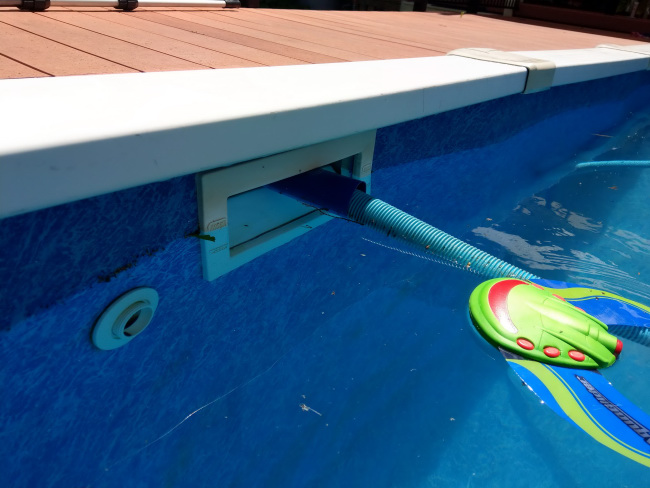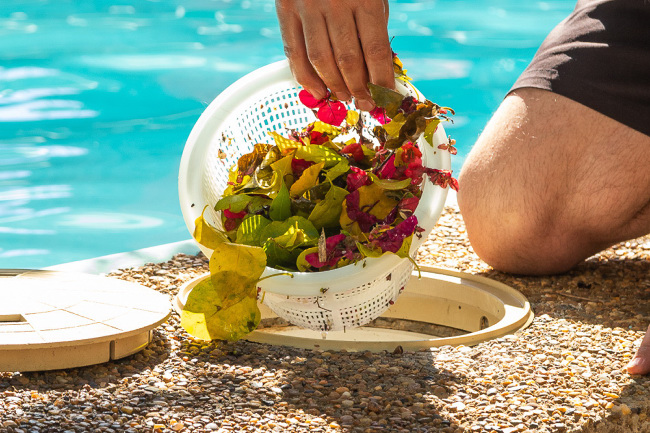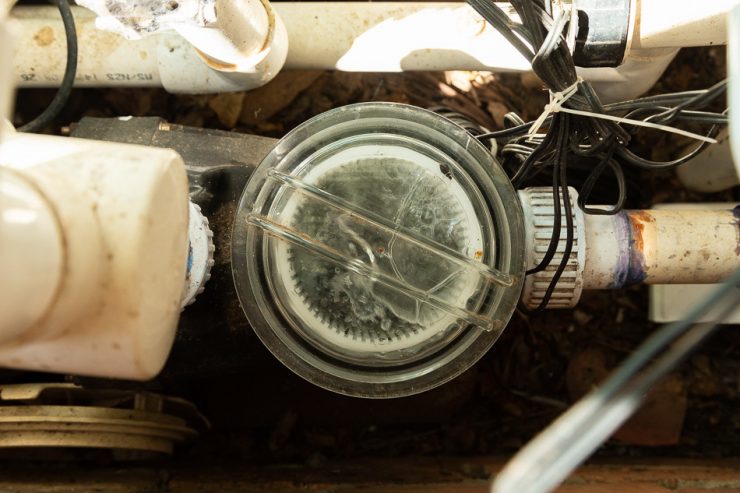You don’t have to be a professional contractor to know that if your pool pump is surging, there’s a problem. Instead of the familiar, consistent hum, you hear an unsettling pulsing noise.
Well, that noise is actually the result of an interruption in the flow of water, which happens when your pump loses prime and has to reprime again and again.
The most common reasons a pool pump surges and pulses are:
- Low pool water level
- Skimmer weir door stuck or sticking
- Blocked or partially blocked pipe
- Blockage in Impeller
- Clogged skimmer or pump basket
- Air leak
- Faulty Pump
Of course, the noise is only a small part of the trouble. If your pool pump is left surging for long enough, it can cause poor circulation, resulting in cloudy water or algae.
While it’s easy to identify a surging pool pump, diagnosing the root cause of the problem is a bit trickier. That’s why we created this guide to help you pin down the exact reason why your pool pump is pulsing and figure out the best way to fix the problem.
Article Contents
Why Pool Pumps Surge and Pulse
Surging or pulsing in a pool pump is usually caused by insufficient water flowing to the pump. If the pump cannot suck in enough water, the pump will not run smoothly.
Insufficient water flow is caused by a number of reasons and can often be quite easy to fix.
Here are the most common reasons why pool pumps surge and pulse.
1. Low Pool Water Level Can Cause Pulsing
Let’s start with the simplest and easiest reason why your pump might be surging.
In some cases, the reason the pool pump pulses are as simple as low water levels. If the pump draws water through the skimmer and the water level is low, it is only a matter of time before the pump sucks in some air. This will cause bubbles to form, causing a surge in your pump.
If the water level is just a bit too low, you’ll only hear the surging on occasion. But if it gets low enough, the pulsing will happen constantly.
How Can You Tell the Water Levels are Insufficient?
The rule of thumb is that the water should be about halfway up the skimmer. However, not all pools were created equal, so this rule may not apply to yours.
Luckily, there is a tried-and-true telltale sign of low water levels, and you can check for it by looking inside the skimmer while the pump is on. If you notice a small vortex of water forming once every few seconds, there’s not enough water in the pool.

How to Fix Insufficient Water Levels
There is no easier fix than topping up your pool with more water.
Of course, waiting to hear the pulsing noise from your pump is not a great way to tell when it’s time to add more pool water. So if you want to ensure the problem never arises again without potentially ruining your pump, consider investing in an automated water level controller. You can get it here:
- Maintains correct pool water level
- Doesn't damage the pool pump
- Automatically fills pool when water is low
2. Skimmer Weir Flap Stuck or Sticking
The skimmer weir door, some people call it the skimmer flapper, gate or door, is supposed to open and close freely. Its job is to keep debris inside the skimmer niche. It does this by closing automatically when the pump is switched off.
If the weir flap is stuck closed, or in an up position, the water flowing into the skimmer will be restricted. This is enough to cause a surging pump or for the pump to lose prime.
How to Fix a Stuck Skimmer Weir Flap
First, check for debris that may have lodged and jammed the door closed. Next, you want to remove the flap and check for cracks or broken parts.
Sometimes the door can get misshapen, causing it to rub on the side of the skimmer. In this case, either replace the flap, or you may be able to trim a 1/2″ off the side of the flap with a hacksaw.
3. Blocked or Clogged Skimmer or Pump Basket
It’s always best to start with the basics. The next thing to do is empty your skimmer and pump strainer baskets. If these are full of debris, they can be restricting the water enough to cause pulsing or surging in your pump.

While you’re there, check there are no cracks or holes in the baskets. Holes in the basket will let debris through, which can cause other blockages in the lines or other pool equipment.
Related Reading: How to Unclog a Blocked Pool Skimmer Line
4. A Clogged Impeller Can Cause Pulsing or Surges
Whilst you have the pump strainer basket out you can check the impeller for clogs. Debris can sometimes get past the skimmer basket if the skimmer basket has a hole or crack in it. And also if the basket was removed with the pump on.
With the pump switched off at the breaker, reach into the pump housing and feel around for debris. Remove it if you find some. Also, check the pump strainer basket for cracks and holes.
5. Air Leaks Can Cause Surging or Pulsing
All pumps function according to the same basic principles. The moving parts generate pressure by creating a vacuum, which is then filled up with water. But the only thing that separates a pool pump from a regular pump is that it’s sealed off from the air. If even the tiniest air leak is present, this can cause the pump to lose prime.
How Do You Know if an Air Leak is Causing Surging?
As mentioned already, the pool system is sealed and should not contain air.

There are several signs you have an air leak that you can check:
Air in pump lid: when you look in through the pump lid, it should be full to the brim with water. There should be no or very little air here.
Bubbles coming out of jets: after the pump has been running for a few minutes, you should see very few air bubbles coming out of the returns jets. If you do, this could mean you have an air leak which leads to pump pulsing.
Low pressure: check the pressure gauge on your filter. If the pressure is lower than normal, it could indicate an air leak.
Related Reading: 12 Reasons Pool Pumps Leak (and How to Fix)
Common Places for Air Leaks
Air leaks can arise for a number of reasons and are on the suction side of the pump. That is, the leak is between the pool skimmer or inlet and the pump.
Here are the most common sources of air leaks that can lead to your pool pump surging and/or pulsing:
- Unions, Valves, and Pipe Joins
The most common place for a pipe to leak is at a join in the pipe or at a valve. This can be the unions, the o-rings inside the o-rings, glued pipe joiners, the joins at valves, or the o-rings inside the valves. - Pump Lid
For your pump to function properly, the lid needs to be tightly secured at all times.
Check the o-ring on the lid. If it’s misshapen, loose, or cracked it can cause an air leak. Also, check the lid. If your lid is cracked or seems ill-fitted for the pump, it may have warped due to prolonged exposure to heat. - Pump Drain Plug
Sometimes, pool pumps will leak air from the drain plug at the bottom of the plug. This is usually fixed by replacing an o-ring or gasket. - Cracked Impeller Housing
The impeller is what draws the water from the pool into the pump. Over time, the housing can weaken and eventually crack.
How to Diagnose an Air Leak
There are several methods you can employ. We’ll focus on three:
- Dish suds
- Using a garden hose
- Shaving cream
Dish Suds: make up a bubbly mix of dish soap and simply put the bubbles on the suspected leak location. With the pump turned on, check if the bubbles are getting drawn into the pipe or pump. If they are, that’s where the air leak is. You can put the bubbles around the pump lid, pipe joins, and valves.
Garden Hose: with the pump on and the garden hose on gentle, run the water over the suspected leak for 15-20 seconds. If the air in the pump strainer goes away and fills with water, you’ve found your leak. Be careful to start at the bottom and work your way up. This is so you don’t misdiagnose the spot from water flowing down.
Shaving Cream: all you need is a can of shaving cream! That’s right, just rub a generous amount around the possible sources and turn on the pump. The shaving cream will get sucked inside the pump, and you’ll be able to spot even the tiniest leak. Generally, the other above methods will work better though.
Related Reading: Air Bubbles In Pool Or Pump | Causes and Dangers
6. Blocked Suction Pipes Can Cause Pulsing
Another common cause of surging might be an object stuck inside one of your pipes (lines) on the suction side of the pump.
When a suction pipe is even partially obstructed, the blockage usually gets lodged in the nearest 90-degree turn it encounters. As water is pumped through the pipe, the obstruction moves around, eventually blocking enough of the flow to make your pump lose its prime and pulse or run dry.
And if you’re thinking “what could have possibly gotten into the skimmer?”, you’d be surprised just how often it happens. The list of items pool owners have found stuck in their pipes is endless, but here are the usual suspects:
- An ill-fitted winterization plug that became detached;
- Large insects;
- A piece of plastic that broke off from another piece of pool equipment;
- Children’s toys;
- Debris such as leaves, hair, acorns, etc.
- Clothing
Related Reading: How Long Should I Run My Hot Tub Filter?
How to Check for Clogged Pipes?
The first thing is to check if there is air in the pump strainer (look under the lid). This means you could have a blockage or an air leak.
You may have also noticed that water is slow to enter your skimmer. This can indicate a problem too and will cause the pump to pulse or surge.
The next thing to do is to try switching the valve (Jandy valve) from “Skimmer” to the “Main Drain”. If the pump stops pulsing and the pressure returns to normal on the filter pressure gauge, then the skimmer line is clogged.
As we mentioned earlier, whatever is obstructing the flow will be lodged in the nearest 90-degree fitting. So, to make sure the pipes are clear, you’ll need to either partially take apart the skimmer piping, or use a Drain King as described below.
- Easily unblock pool lines, kitchen sinks, showers & more
- Attaches to a garden hose
- Suitable for 1-1/2 inch to 3 inch diameter drains
How to Fix a Clogged Pipe?
Believe it or not, there are some DIY weekend warriors out like tackling problems like this.
The easiest thing to start with is by checking under the skimmer basket. With the pump switched off, remove the basket. With your fingers, pull out any debris lodged in the pipe opening at the bottom of the skimmer. If you had debris here, it may be the problem.
If this doesn’t fix it, you can try a Drain King. Any similar product will work. First, try putting the Drain King in the skimmer suction inlet located under the skimmer basket.
If that doesn’t clear it, try it from inside the pump. Take out the pump basket and put the hose into the pump’s inlet port. With any luck, The obstruction will be pushed out of the pipes and into the pool.
7. Faulty Pump
Most pump systems available today are rated to last 4-8 years. But sooner or later, they all simply become worn out.
Alas, there are no “check engine” lights on pool pumps. The only sure way to check if your pump is nearing the end of its life is to replace it with a new one. If the pulsing stops, you’ve found the issue.
Related Reading:
Why Your Pool Pump is Noisy and How to Fix It (Quiet it)
How to Fix a Pool Pump that is Humming & Not Working



